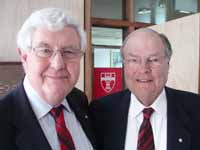Projected health budget savings from the federal government’s proposed introduction of means testing for health insurance rebates should be re-directed to establishing a new rural medical school at Charles Sturt University (CSU), according to a leading medical expert.
 Professor John Dwyer, founder of the Australian Health Care Reform Alliance, and who for the last two years has been studying the reasons for the rural doctor shortage with colleagues from CSU, says, “Rural Australians, whose poorer health outcomes are directly related to the shortage of doctors in the ‘bush’, won’t get too excited if more money is made available to the present general practitioner (GP) training scheme, as it has not seen more Australia-trained GPs pursuing a rural career.”
Professor John Dwyer, founder of the Australian Health Care Reform Alliance, and who for the last two years has been studying the reasons for the rural doctor shortage with colleagues from CSU, says, “Rural Australians, whose poorer health outcomes are directly related to the shortage of doctors in the ‘bush’, won’t get too excited if more money is made available to the present general practitioner (GP) training scheme, as it has not seen more Australia-trained GPs pursuing a rural career.”The federal government expects to recoup $2.4 billion over the next three years as a result of introducing a means test to determine who will have their insurance subsidised. For a number of years, many have called for such a change, as the rebate scheme established to reduce the demand for public hospital services had failed to do so. The present government agrees that better health outcomes could be obtained from those dollars if their use was better targeted.
“But what should those targets be?” asks Professor Dwyer, who welcomes the Commonwealth Heads of Government (COAG) agreements providing better financial arrangements for public hospitals and the availability of significantly more dollars to strengthen mental health programs and services to people with disabilities.
“Now a very strong case can be made to use the recovered rebate dollars to tackle two serious inequities within our health care system; namely, the lack of a public oral health scheme, and the lack of initiatives needed to improve the health of rural Australians who do not enjoy the standard of health available to their metropolitan cousins.”
Health experts have been urging the government to spend all the dollars gained on health rather than returning the money to consolidated revenue as significant health care needs remain underfunded. The Minister has indicated that more money for dental care ($165 million), regional cancer centres, and GP training, would be considered.
“The chronic shortage of doctors, which sees rural Australians dependent on the availability of overseas-trained doctors, should be tackled using new initiatives strongly supported by evidence from abroad and by our own studies in Australia,” Professor Dwyer said.
“There is world-wide evidence that supports the observations made at Charles Sturt University where 70 to 80 per cent of its health care students who enter university with a strong affiliation to rural life and are trained in the country, stay in the country. Far too few rural students are studying medicine. Rural Australians deserve to be cared for by doctors who want to be in their town, and who have enjoyed a rural-focused curriculum that gave them the specific skills needed to be successful in rural Australia.”
Professor Dwyer says a second initiative is required to break down the ‘silo’ mentality that prevents the true integration, in a patient-focused manner, of the care available from different health disciplines.
“This is particularly important in rural areas where it is imperative to use the scarce health workforce wisely. Charles Sturt University, which offers the largest suite of health care courses in Australia, is dedicated to the application of the principle, ‘team learning to prepare for team practice’. It applies an inter-professional learning strategy that sees health students from different disciplines share classes to examine the advantages of multi-disciplinary partnership and care.
“Financial pressures have made it difficult to obtain start-up dollars for a rural medical school for students who plan to pursue a rural career, and to teach them in the new inter-professional education model with a rural-specific curriculum,” Professor Dwyer said.
“All rural Australians, and indeed all of us responsible for the education of the next generation of health students, should be urging the government to use these newly available dollars to support these innovations. I am certain better health outcomes will be provided than was the case with their use to support private health insurance.”





Social
Explore the world of social